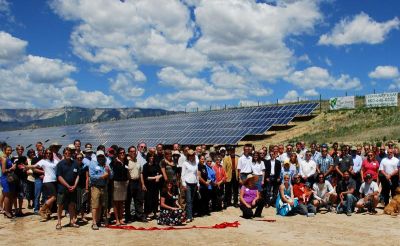Week in review: Put away the white shoes and keep going solar
 Now that Labor Day has passed, and with it the unofficial end of summer, it’s time to put away the white shoes but by no means is it time to stop going solar. Last week a fair amount of new solar research was announced, led by more support from the DOE’s SunShot Initiative, but last week also saw what’s likely the first solar Kickstarter project get underway. Meanwhile the U.S. Army introduced it’s hefty first RFP which could cover up to $7 billion in solar projects. And California’s residential solar market has surpassed $1 billion in third-party ownership solar projects.
Now that Labor Day has passed, and with it the unofficial end of summer, it’s time to put away the white shoes but by no means is it time to stop going solar. Last week a fair amount of new solar research was announced, led by more support from the DOE’s SunShot Initiative, but last week also saw what’s likely the first solar Kickstarter project get underway. Meanwhile the U.S. Army introduced it’s hefty first RFP which could cover up to $7 billion in solar projects. And California’s residential solar market has surpassed $1 billion in third-party ownership solar projects.
The U.S. Army and the Army Corps of Engineers have unveiled a $7 billion Multiple Award Task Order Contract (MATOC) that seeks proposals from multiple solar developers. After reviewing the proposals—the list could be long, over 600 solar industry representatives arrived at a recent conference to learn about the MATOC—the Army will create a list of preferred contractors across the country. It will then open up bids for individual projects as they come up.
Meanwhile, a new study from SunRun and PV Solar Report using California Solar Initiative data and other sources found that residential third-party ownership of photovoltaic arrays has now generated more than $1 billion in California’s economic growth. Not bad, considering that just about five years ago, there were scant—if any—companies offering solar leases or power-purchase agreements for homeowners. The report also found that roughly 75 percent of homeowners in California are opting for such agreements rather than purchasing or financing a system outright.
Last week the Department of Energy’s (DOE’s) SunShot Initiative announced a total seven new investments into new solar research to establish Scientific User Facility research partnerships and instruments as well as concentrating solar power (CSP) heat transfer technologies.
Ceres Technologies invested $20 million at the University of Albany’s College of Nanoscale Science and Engineering’s Albany NanoTech Complex in New York. The money will support research into the next generation of manufacturing equipment for copper indium gallium selenide (CIGS) PV cells. Ceres also joined the U.S. Photovoltaic Consortium (PVMC) at the university a public-private partnership with, among others, the SunShot Initiative.
Another part of the puzzle may require more microwaves. Oregon State University is looking at microwave ovens to better cook the nanomaterials that will go into the next generation of photovoltaics. Essentially researchers found that microwave ovens do a more even, more controllable job of cooking the nanomaterials, like nanoinks, prior to applying them to a backing sheet, because the microwave processing is better at developing the proper crystal structure for the materials.
Still, not all solar inventions come from universities. Two inventors are bringing their idea to, the Pocket Solar Factory, to Kickstarter. The inventors are looking to the crowdfunding site to raise $50,000 to develop a device that can manufacture reliable, long-lasting small-scale photovoltaics or microsolar modules, like those used to charge smartphones and other portable devices (update - they have raised $100,000 so far.)
Community solar gardens are starting to grow across the U.S. Likely the most recently completed garden is the 116 kilowatt solar garden installed by the Poudre Valley Rural Electric Association (PVREA) in Fort Collins, Col.
Solar’s also taking to the waves this summer. Liquid Robotics, Inc.’s newest robot, Alex, is taking on its biggest challenge yet, hurricane season. The device is out in hurricane alley under orders from the U.S. National Oceanographic and Atmospheric Administration’s (NOAA’s) Atlantic Oceanographic and Meteorological Laboratory (AOML) to research the affects of tropical storms and hurricanes in a way that’s never been done before.



